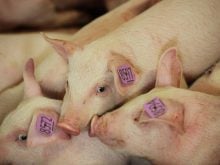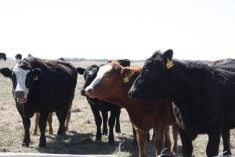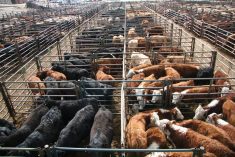The big white breed added a splash of colour to this year’s Calgary Stampede Charolais show.
There were a few double takes when red and black purebred Charolais paraded before judge Jack St. Arnaud.
The black bull and cow, along with a red heifer, are part of a partnership between Henrik and Jeralyn Rasmussen of Innisfail, Alta., and Char-Maine Cattle at Cardston, Alta. The company is called Men in Black.
The Rasmussens own about 20 black females and an assortment of reds among their 130 purebred Charolais cows.
Read Also

VIDEO: Ag in Motion documentary launches second season
The second season of the the Western Producer’s documentary series about Ag in Motion launched Oct. 8.
The blacks were part of an upgrading program started five generations ago when Charolais bulls were mated to Angus cows. Careful selection by breeding their cows back to coloured bulls retained the black, which is popular in the United States.
“Here in Canada there are quite a few people breeding Charolais to Black Angus cows,” said Henrik after the Stampede show, where his cattle placed in the middle of their classes.
When they brought their cattle into the Charolais barn, they automatically drew attention.
“We were teased about being in the wrong barn,” said Jeralyn, who led out the first black Charolais female to appear at the summer show.
There is growing interest in the United States where black cattle are favoured for the certified Angus beef program. However, the American Charolais association refuses to register them as purebreds.
The Canadian association stipulates coloured cattle include the letter Q in their pedigree at registration time.
“The Americans like Black Angus and they want black Charolais. There’s a powerful market in North Dakota, Montana and Wyoming,” said livestock consultant Don Pochylko.
The Rasmussens had a small commercial herd when they entered the purebred business in 1988.
They bought their first coloured Charolais at the annual Red Bonanza event in Red Deer.
“We liked the colour of the cattle,” Henrik Rasmussen said.
With encouragement from Pochylko, they made their way through the purebred industry with a special emphasis on coloureds.
Black is a dominant trait so breeding for colour is relatively easy, said Pochylko. However, animal quality should not be sacrificed for colour.
“We’re looking for performance, not colour,” he said.
Still, people watch red and black Charolais for flaws because some fear breeding for colour could sacrifice other more valuable traits.
“As long as the cattle are good, they can’t say too much. If there are bad ones, we don’t keep them,” said Rasmussen.

















